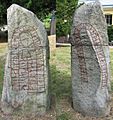Runestone facts for kids
A Runestone or Rune stone is a large stone, with runes inscribed on it, dating from the early Middle Ages. Currently, about 6000 such stones are known to exist in Scandinavia. About half of them date from the tenth and eleventh century, and were found in Sweden. Most of them are like grave stones. They announce the life and death of a local person. About 10 percent of the known stones tell about the travels and deaths of persons abroad. Some of these texts are similar to what Scandinavians who travelled to Byzantium have written in Latin.
Images for kids
-
An early runestone: the Möjbro Runestone from Hagby (first placed near Möjebro), Uppland, Sweden. As with other early runic inscriptions, (e.g. Kylver Stone from about 300–400 CE) this is written from right to left, while later Runestones were written from left to right. The text is "Frawaradaz anahaha is laginaz".
-
The Snoldelev stone, one of the oldest runestones in Denmark
-
Piraeus Lion drawing of curved lindworm. The runes on the lion tell of Swedish warriors, most likely Varangians, mercenaries in the service of the Byzantine (Eastern Roman) Emperor.
-
The Kingittorsuaq Runestone from Greenland
See also
 In Spanish: Piedra rúnica para niños
In Spanish: Piedra rúnica para niños

















